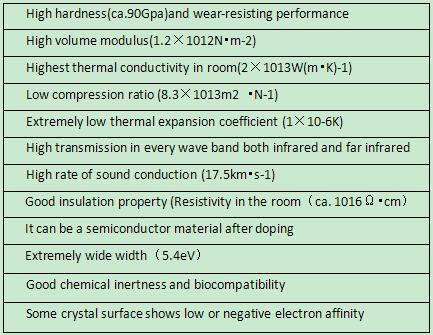Company tel:+86-379-63184520
Contact number:+86-15937921751
Postcode:471000
Email:info@yuxindiamond.com
Address:3-1-508 Luoyang National University Science Park, No. 2 Penglai Road, Jianxi District, Luoyang, China 471000
Superconducting And Diamond Qubits Get A Boost
Important challenges in creating practical quantum computers have been addressed by two independent teams of physicists in the US.One team has created a new way of reading-out superconducting quantum bits(qubits),while the other has come-up with a new way to get spin qubits in diamond to interact with each other.

Any viable quantum computer needs isolated quantum states that can store qubits of information for relatively long periods of time.It must also be possible for these qubits to interact with each other at appropriate times so that the information can be processed and the results read-out.It is these often-conflicting requirements that made it very difficult to create a practical quantum computer
Diamond vacancies
In a second paper in Science,Mikhail Lukin and colleagues at Harvard University used two silicon-vacancy centres(SiVs)in diamond as two qubits.A SiV occurs when two neighbouring carbon atoms in the diamond lattice are replaced by one silicon atom.The spin of the SiV makes a good qubit because it is isolated from electrical noise yet interacts with light at certain frequencies.
The challenge is getting SiVs to interact with each other.The team placed two SiVs in an optical cavity,which dramatically increases the probability that they would interact:“The two SiVs are a bit like two people in a dark room trying to send Morse code signals to each other using dim flashlights,”explains Harvard’s Ruffin Evans,“If you form a cavity by placing mirrors back-to-back on each wall,the light bounces back and forth and gives the people many more chances to see the signal.”When tuned into resonance at the same frequency,states from the two silicon vacancy centre states were mixed by the interaction to form a super-radiant“bright”state and a non-radiant“dark”state.
Creating two interacting qubits is not new and other researchers have gone further and created working quantum-logic gates using different qubit technologies.Evans explains,“The novelty of our work is that,even though the interaction between light and matter is normally very weak,we’ve still been able to create an interaction between these two silicon vacancy centres using light.The next step is to harness this interaction to create a real quantum gate.”Such a device system should lend itself naturally to the creation of a“quantum internet”that uses photon-based qubits sent long distances through fibre optic cables.
“Beautiful scheme”
Barry Sanders of the University of Calgary in Canada told Physics World that both teams’research is significant–but for different reasons.He believes the McDermott group’s work has clear potential for direct application to quantum computation if the measurement fidelity can be increased.“Superconducting circuits are generally regarded as the most promising direction towards making scaleable quantum computing,but a big drawback has always been the lack of single photon detection,”he says.“This is a beautiful scheme and it looks scaleable to me.”
The relevance of Lukin group’s work to quantum computation is less clear but it may have unforeseen applications.Sanders says,“For a long time,we’ve got away with treating multi-atom systems as a single atom with an effective background.When we get to phenomena like super-and sub-radiance,we’re talking about two-body effects with atoms sharing photons between them.These guys have done everything just right that they’re able to tune into and out of this collective behaviour.It’s a huge challenge in fabrication and control and their results are convincing and elegant.”
Diamond,as one of the most special materials in natural world,is featured with the highest hardness,low friction coefficient,high elasticity modulus,high thermal conductivity,high insulation class,wide energy gap,great sound propagation rate and favorable chemical stability,which are presented in below Table.In spite of such unique features,the natural diamond has always been existed in the form of gem,with its variability and rareness sharply limiting its application.Luoyang Yuxin Diamond Co.,Ltd‘s CVD Diamond film,on the other hand,integrates such physical and chemical properties,with lower cost than natural diamond and applicable to be made into various shapes,thus enjoying extensive application prospect in electronic industry,optical field and mechanical industry.








